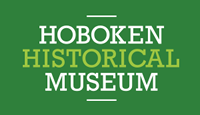A Short History of Hoboken
Hoboken’s modern history began when Henry Hudson’s navigator made note of the area’s green-veined rock during the 1609 voyage up the river that now bears the explorer’s name. The men on the ship Half Moon were the first Europeans known to have seen the island.
The Lenni Lenape camped seasonally on the island, and were not permanent residents. They called the spot “Hopoghan Hackingh,” or “Land of the Tobacco Pipe,” for they used the green-colored serpentine rock abundant in the area to carve pipes for smoking tobacco. Another possible origin for the name “Hoboken” is that Dutchmen who followed Henry Hudson called the area “Hoebuck,” meaning “high bluff.” Today we call the elevation Castle Point. In 1658 Peter Stuyvesant, Dutch Governor of Manhattan, bought all the land between the Hackensack and the Hudson Rivers from the Lenni Lenape for 80 fathoms of wampum, 20 fathoms of cloth, 12 kettles, 6 guns, 2 blankets, 1 double kettle and half a barrel of beer.
Subsequently the land came into the possession of William Bayard. Because he chose to be a Loyalist Tory in 1776, his land was confiscated by the Revolutionary Government of New Jersey. In 1784 Colonel John Stevens, Colonial Treasurer of New Jersey and Patriot bought the island at public auction for 18,360 pounds sterling, then about $90,000. Stevens envisioned this marshy island’s possibilities. He settled on the name “Hoboken” and the Stevens family began to be an inseparable part of the city’s history.
Stevens developed Hoboken as a resort, with the people of New York City his market. As early as 1820 he began transforming the wild but beautiful waterfront into a recreation area. He constructed a riverfront walk and a park space in today’s downtown Hoboken. Weekends, the city-to-be accommodated as many as 20,000 New Yorkers out for their Sunday picnics.
On June 19, 1846 Hoboken played host to the first organized game of baseball. The New York Nine defeated the Knickerbockers, 23 to 1 in four innings at Hoboken’s Elysian Fields near the current site of Elysian Park and the former Maxwell House facility. Learn more about baseball’s origins and check out the earliest known depiction of a baseball game at Elysian Fields here.
Numerous attractions in Hoboken drew celebrities of the time. George Washington was an honorary member of the Turtle Club, which met near the Elysian Fields at Tenth Street; Alexander Hamilton and Aaron Burr were active members. Charles Dickens wrote about his visit to Hoboken in 1842. John Cox Stevens began America’s first yacht club in Hoboken in 1844; America. Lillian Russell, John L. Sullivan, Jay Gould, and William K. Vanderbilt entertained guests in Hoboken’s Duke’s House restaurant. Horace Greeley and Henry Ward Beecher frequented Nick’s Bee Hive, a lively saloon. John Jacob Astor build a summer home at Washington and Second Streets.
Colonel Stevens became best known as an inventor considerably ahead of his time. In 1791 he received one of the first patents issued in America, for a steam engine application. Thirteen years later his vessel Little Juliana steamed across the Hudson between the Battery and Hoboken. It was the first steamboat driven by twin-screw propellers. In 1808 Colonel Stevens launched the Phoenix, the first steam-driven vessel to make an ocean voyage.
Stevens then turned his attention to rail transportation. By 1826 he had designed and built the first experimental steam-driven locomotive in the U.S. and operated it on a circular track in Hoboken. Stevens earlier received the first American railroad charter. His charter was developed by his capable sons, one of whom designed the “T” shaped rail that is standard to this day on American railroads. Colonel Stevens died in 1838.
With this early start and the city’s waterfront location opposite New York, Hoboken established itself as a rail and water transportation center. Piers sprouted along the waterfront and Hoboken became a major port for transatlantic shipping lines, including Holland America, North German Lloyd, and Hamburg-American. Hoboken’s facilities and strategic location made it the choice of the Federal government as the prime port of embarkation for troops of the American Expeditionary Forces in World War I. More than three million soldiers passed through the port, and their hope for an early return led to the slogan, “Heaven, Hell or Hoboken…by Christmas.”
Most of Hoboken’s buildings were erected in the 19th Century to standards set by the Hoboken Land & Improvement Company, created by the Stevenses in 1838 to manage the city’s development. Stevens created Hoboken’s orderly street pattern, and brought a consistency and coherence to its architecture. The township of Hoboken was formed and separated from North Bergen in 1849. The City itself was incorporated on March 28, 1855.
Hoboken’s rapid growth from 1860 to 1910 and its role as a gateway to America brought many immigrants from Europe to the city. The Germans were the first, and German became a dominant language throughout Hoboken. After World War I, the city’s ethnic character changed. Germans were followed by Irish, Italians, Yugoslavs, Latinos and Asian Indians. Hoboken’s ethnic vitality enriches the city’s contemporary life.
Containerization of ship cargo made the city obsolete as a center for shipping. Hoboken’s warehouses and lack of vast open spaces couldn’t accommodate the large containers. This sparked a severe economic decline that reached its nadir in the 1970s. However, this preserved the old buildings and streets from the changes that prosperity could have brought in the guise of progress.
Today, Hoboken is a colorful composite of cultures, each with its festivals, languages, music, businesses and clubs. Hoboken is also home to a large and growing population of individuals identified not by the diverse ethnic tapestry they constitute, but by their education, careers, families and life choices, among them the choice of making Hoboken an enriching part of their lives.
